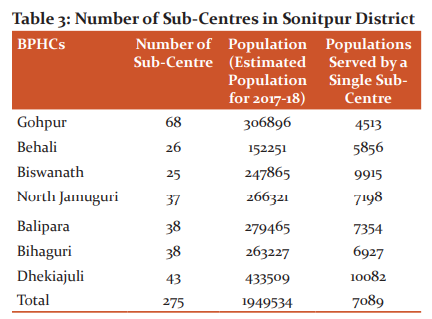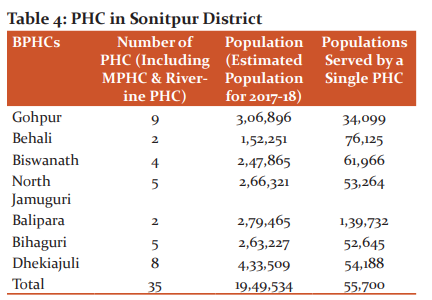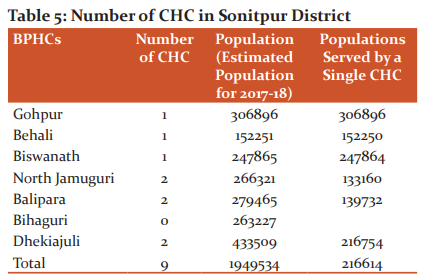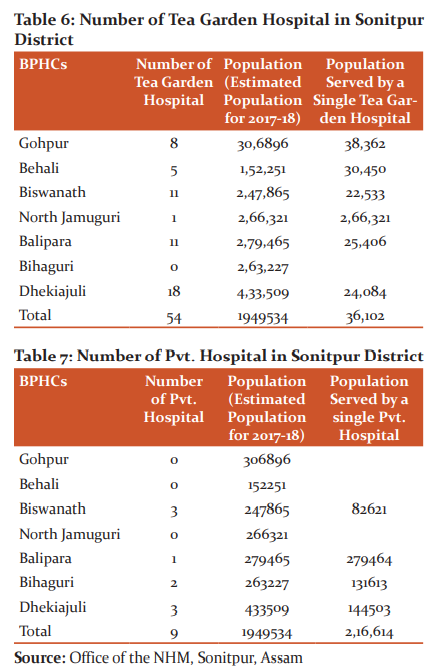IJCRR - 13(3), February, 2021
Pages: 149-153
Date of Publication: 03-Feb-2021
Print Article
Download XML Download PDF
Spatio-Temporal Distribution of Diseases and Healthcare Facilities in Sonitpur District of Assam
Author: Sameer Baruah
Category: Healthcare
Abstract:Introduction: The environmental factors of Sonitpur district are highly responsible for the frequent occurrence of diseases like Malaria, Japanese Encephalitis, Diarrhea, Viral Hepatitis, Dysentery, Enteric Fever and the like. The district witnessed the frequent occurrence of such diseases from time to time. Within the district, there has been a spatial distribution of such diseases from one health block to another. Moreover, the distribution of health institutions or medical facilities like Hospitals, CHCs, PHCs and Health Sub-Centers is not uniform throughout the region. Some parts of the region have more health institutions, while some others have less number of the same. Objectives: The main intention of the study is to examine the spread of diseases and associated factors. The work also takes care to co-relate the spread of diseases and inadequacy of medical facilities in the Sonitpur district of Assam. Methods: The whole study is mainly based on secondary data. In a few cases, internet links are also taken into consideration for detail analytical study. The study will explain the trend of certain diseases and associated factors in the region. Moreover, an analysis of the existing health care facilities will give an idea about the availability and adequacy or otherwise of the same in the district. Results: The study revealed that health blocks with less number of health institutions are characterized by the higher frequency of diseases like Diarrhea, Hepatitis etc. The health institutions of the same are also facing high population pressure due to the deficiency of health institutions. Conclusion: The entire study has given an idea about the disease pattern in different health blocks of the region. The study also reflects the adequacy as well as deficiency of health infrastructure in the study area. The study will help the Medical Geographers as well as other health experts to take crucial steps for better health planning in the region.
Keywords: Endemic diseases, Frequency of occurrence, Spatial distribution, Health infrastructure
Full Text:
Introduction
Geography, generally, concerned with the relationship between man and environment, and in the recent time, a new branch of study known as ‘Medical Geography’ has been emerged into the discipline of geography which particularly deals with all the aspects of human health inclusive of the distribution pattern of diseases, nutrition and health services. Medical geography is a study of the relationship between the pathological factors which cause disease and the geographical factors which give rise to that pathological factors.1 Medical geography sometimes referred to as ‘Geography of Health’. Geography of health is concerned with the distribution and comparison of various indices of disease in the human population and the interrelation with other elements of the physical, biological and cultural environment in space. The environment may be taken as a place of risk where the man may be passively experiencing some kinds of health hazards.2,3
The World Health Organization has defined health as a state of collating physical, mental and social well-being and not merely the absence of disease or infirmity.4 According to some geographers, the geography of health is also the study of spatial distribution or extension of health care facilities i.e. health institutions in an area. Medical geography studies the changes in health conditions and variation of diseases and associated factors. The W.H.O. definition of health projects three different dimensions of health. Physical, Mental and Social well-being is closely related to one another. The fourth dimension has also been suggested which is ‘Spiritual’ health.1,5,6
Assam, the most populous state of North-East India, is endemic for diseases like Malaria, Japanese Encephalitis, Diarrhea, Viral Hepatitis, Dysentery, Enteric Fever etc. The climate of Assam which is sub-tropical humid provides favourable conditions for the occurrence of such diseases. Malnutrition and deficiency diseases are one of the major health problems of today.7
The district of Sonitpur in question represents the study with such diseases for further discourse concerning its environment. The natural environment in which people live and settle becomes the major aspect for a pattern of disease from which they suffer. Thus the systematic study of the spatial distribution of disease concerning the environment in which the affected person lives forms the main concept of the study of medical geography.5
That the peculiar environment, occupation and living condition of the people of Assam is responsible for their vulnerability towards malaria attack has been recounted by M’Cosh in his book Topography of Assam as early as 1837.4,6 The environmental factors of the district are highly responsible for the frequent occurrence of all these diseases.2 Moreover, the distribution of health institutions or medical facilities is not uniform throughout the region. Some parts of the region have more health institutions, while some others have less number of the same. Therefore, an attempt is made here to examine the spread of diseases and associated factors. The work also takes care to co-relate the spread of diseases and inadequacy of medical facilities in the Sonitpur district of Assam.9 The study will formulate a better plan for better health, and will also be helpful for the health department to improve health services in the region by finding a suitable location for health institutions.
Materials and Methods
In the study, only secondary data are used. To collect relevant data many sources have been taken into consideration. Data concerned with the spatial distribution of various diseases in the study area have been collected from the Office of the Health & Family Welfare (IDSP), Sonitpur District, Assam. Data about the distribution of health care facilities or health institutions in the study area have been collected from the National Health Mission (NHM) office, Sonitpur District, Assam. Moreover, books, as well as journals related to Medical Geography, are also taken for detail analytical study. In a few cases, internet links have also been taken into consideration for further study.
In the study, the spatial distribution of some selected diseases along with the distribution of health care facilities are proposed to be analyzed at the block level of the Sonitpur District. The study is carried out by taking seven health blocks with certain specific diseases. Analysis has been done with absolute data on the incidence of diseases. The collected data have been systematically tabulated to show the temporal as well as the spatial variation of the incidence of diseases in all the health blocks of the district. Taking into consideration of the above methods, the proposed study has been done properly.
Results
Temporal Distribution of Diseases
Sonitpur district is characterized by a wide range of disease variation within its territory. Various diseases have been found to be occurring in different parts of the district. Certain areas of the district are attributed to some specific types of diseases because the factors associated with various diseases are found to be varying from one part to another in the district. Besides environmental conditions, man’s habits are also responsible for the distribution of diseases in any place.1 Among the diseases Diarrhea, Dysentery, Viral Hepatitis, Malaria, Japanese Encephalitis, Enteric Fever etc. is found to be quite frequent in different parts of the area. However, the incidence of Dengue is also diagnosed in a few areas of the district. Table 1 and Table 2 are based particularly on the data collected from different reliable sources and hospital records:
 Source: Office of the Health & Family Welfare (IDSP), Sonitpur
Source: Office of the Health & Family Welfare (IDSP), Sonitpur
 Source: Office of the Health & Family Welfare (IDSP), Sonitpur
Source: Office of the Health & Family Welfare (IDSP), Sonitpur
Spatial Distribution of Healthcare Facilities
The distribution of health care facilities may be explained in terms of the population or community for whom they serve. These health care services are considered as an essential part of a health system and it reflects an important response to health concern and the needs of the health.3
The followings are the availability of healthcare facilities in different health blocks of the district:
Sub-Centres
In the study area, the numbers of sub-centre are very high compared to the numbers of all the health care institutions. The total number of sub-centre in the study area is significantly 275. The average number of sub-centre per health block of the study area is about 39, which is satisfactory. From this perspective, sub-centres are well-developed in the study area. Table 3 shows the BPHC-wise number of Sub-Centre (SC) and the persons served by a single Sub-Centre in the study area.

Source: Office of the NHM, Sonitpur, Assam
Primary Health Centre (PHC)
In Sonitpur district the total number of PHC including the MPHC (Mini Primary Health centre) and Riverine PHC is only 35. The average number of PHC per health blocks of the district is only 5, and the persons served by a single PHC in the study area are 55,700. Table 4 shows the BPHC-wise number of PHCs and the persons served by a single PHC in the study area.

Source: Office of the NHM, Sonitpur, Assam
Community Health Centre (CHC)
In the study area, the total number of CHC is very less i.e. only 9. These nine CHCs are almost uniformly distributed among the health blocks of the study area. The average number of CHC per health block hardly cross 1, which is significantly much lower than average number of PHC per health block in the study area. Hence, CHCs are also not well-developed in the study area. The table 5 shows the BPHC-wise number of CHC and also the persons served by a single CHC in the study area.

Source: Office of the NHM, Sonitpur, Assam
Hospitals
In the study area, hospitals are found to be well-developed. In Sonitpur district most of the hospitals belong to tea gardens which are run by private tea companies. There are many big tea gardens located in Sonitpur district, and therefore, tea garden hospitals have been established by the concerned tea company to provide health care services to the local communities. The table 6 and table 7 show the number of tea garden hospitals and private hospitals in the district.

Source: Office of the NHM, Sonitpur, Assam
Discussion
The study, undertaken here, mainly deals with the health aspects of human beings in Sonitpur district to explain the spatial distribution of some selected diseases and extension of health institutions in the seven health blocks. The entire study is consists of selected four diseases namely Diarrhea, Viral Hepatitis, Malaria and Dengue. The temporal distribution of selected four diseases in the Sonitpur district of Assam shows remarkable findings. The whole study is based on BPHC wise distribution of diseases as well as health institutions in the district and the population pressure on the health institutions.
The study has found that almost all the health blocks of the study area are deprived of health services. Gohpur BPHC is the only health block that is somehow well-served by medical institutions. What is needed for other health blocks is proper and careful health planning. Systematic as well as careful health planning by the Government should be made in the deprived health blocks to improve the health status. Efforts should also be made to control Diarrhea, Hepatitis, and Malaria properly. Health institutions like PHC as well as CHC should be increased in almost all the health blocks of the district. The specialized well-equipped hospitals should be started in the deficient health blocks. The extensive health education should be spread for personal as well as public hygiene, distribution of well-equipped required medical services in proportion to the populations, and special health check-up camps especially in the deficient or suffered health blocks would solve much of the health problems of the Sonitpur District.7,8,9
Conclusion
Disease pattern and health infrastructure are related to one another as the disease pattern is largely determined by the expansion of health facilities. In the study area, it has been found that the area characterized by the sufficient number of a health institution is affected by a particular disease in less number. It has also been found that population pressure on health institution is more where there is the insufficient number of the same. Thus, there must be sufficient health infrastructure in the deficient area to stop the spread of disease and also to stop population pressure on the same.
Acknowledgement:
The present article is a part of my M. Phil Dissertation and hence, I would like to express my deep gratitude to my Research Supervisor Prof. Nishamani Kar, Department of Geography, Rajiv Gandhi University, Arunachal Pradesh for his constant support and help, encouragement and proper guidance, without which the current article would have not been possible. I am thankful to Mr. Sanjib Kumar Rajkhowa, DDM cum DNM & e-Officer, NHM (National Health Mission), Sonitpur District for providing me necessary data about health care institutions. I am also thankful to the Health and Family Welfare Department (IDSP), Sonitpur District for providing me required data related to various diseases and their spatial distribution in the district.
Conflict of Interest: Nil
Source of Funding: Nil
References:
-
-
-
-
May JM. Medical geography- its methods and objectives. Geograph Rev 1950;40:10.
-
Armstrong RW. Medical Geography and Risk Assessment. In R. Akhtar and Y. Verhasselt. Eds. Disease, Ecology and Health. Readings in Medical Geography. Rawat Publication. Jaipur. 1990:3-9.
-
Bagchi M. Mosquito-Borne Diseases and Problems of Health Management in Dibrugarh District. Assam: A Study in Medical Geography. Unpublished PhD Thesis. Department of Geography. 2010. Gauhati University. Guwahati. pp. 2-5.
-
World Health Organization (WHO). Basic Documents 16th Edn.1965. I.
-
Choubey A, Kailash K. Environment and Nutritional deficiency diseases in the Eastern Malwa plateau -Unpublished Ph.D Thesis University of Seugar. 1977:1-30.
-
M’Cosh J. Topography of Assam 1837. Logos Press, New Delhi.
-
Sen G. Preventive and Social Medicine. Current Publisher, Calcutta. 1st ed. pp 15-16.
-
Akhtar R. Scope of Geography of Health and Geo-medical research in India. Ann Natl Asso Geograp 1983;3(2):66-77.
-
Park JE, Park K. Preventive and Social Medicine-A Treatise on community health. Banarsidas bhanot publishers, Jabalpur. 1977;l1.
|






 This work is licensed under a Creative Commons Attribution-NonCommercial 4.0 International License
This work is licensed under a Creative Commons Attribution-NonCommercial 4.0 International License